
Ireland had an estimated population of 5,281,600 as of 1 April 2023.
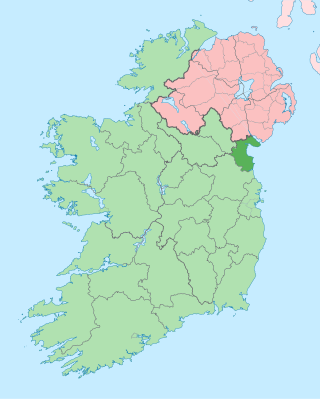
County Louth is a coastal county in the Eastern and Midland Region of Ireland, within the province of Leinster. Louth is bordered by the counties of Meath to the south, Monaghan to the west, Armagh to the north and Down to the north-east, across Carlingford Lough. It is the smallest county in Ireland by land area and the 17th most populous, with just over 139,100 residents as of 2022. The county is named after the village of Louth. Louth County Council is the local authority for the county.
The Central Statistics Office is the statistical agency responsible for the gathering of "information relating to economic, social and general activities and conditions" in Ireland, in particular the census which is held every five years. The office is answerable to the Taoiseach and has its main offices in Cork. The Director General of the CSO is Pádraig Dalton.
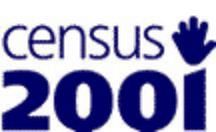
A nationwide census, known as Census 2001, was conducted in the United Kingdom on Sunday, 29 April 2001. This was the 20th UK census and recorded a resident population of 58,789,194.

Urlingford is a town in County Kilkenny, Ireland. It is also a civil parish within the barony of Galmoy. The town is in the north west of the county, along the boundary with County Tipperary, 16 km north-east of Thurles.

Sallins is a town in County Kildare, Ireland, situated 3.5 km north of the town centre of Naas, from which it is separated by the M7 motorway. Sallins is the anglicised name of Na Solláin which means "the willows".
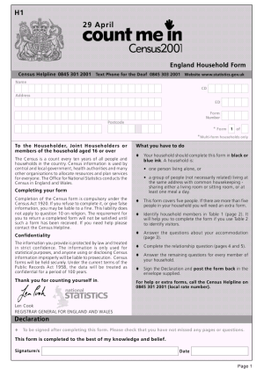
Coincident full censuses have taken place in the different jurisdictions of the United Kingdom every ten years since 1801, with the exceptions of 1941, Ireland in 1921/Northern Ireland in 1931, and Scotland in 2021. In addition to providing detailed information about national demographics, the results of the census play an important part in the calculation of resource allocation to regional and local service providers by the UK government.
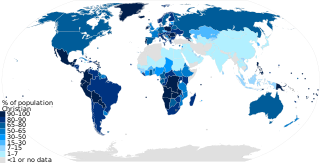
As of the year 2021, Christianity had approximately 2.38 billion adherents and is the largest religion by population respectively. According to a PEW estimation in 2020, Christians made up to 2.38 billion of the worldwide population of about 8 billion people. It represents nearly one-third of the world's population and is the largest religion in the world, with the three largest groups of Christians being the Catholic Church, Protestantism, and the Eastern Orthodox Church. The largest Christian denomination is the Catholic Church, with 1.3 billion baptized members. The second largest Christian branch is either Protestantism, or the Eastern Orthodox Church.

The South-West is a strategic planning area within the Southern Region in Ireland. It is a NUTS Level III statistical region of Ireland. It includes the city of Cork and the counties of Cork and Kerry. The South-West region spans 12,120 km2 (4,680 sq mi), roughly 16% of the total area of the state and according to the 2022 census has a population of 736,489.
The population of Ireland in 2021 was approximately seven million with 1,903,100 in Northern Ireland and 5,123,536 in the Republic of Ireland. In the 2022 census the population of the Republic of Ireland eclipsed five million for the first time since the 1851 census. The population of Ireland in 2016 was approximately 6.6 million. Although these figures demonstrate significant growth over recent years, the population of Ireland remains below the record high of 8,175,124 in the 1841 census.

Derrinturn is a village in County Kildare, Ireland. It is part of the parish of Carbury. It is located about 60 km (37 mi) from Dublin.

Baile Ghib is a small village and Gaeltacht in County Meath, Ireland. It is about 70km northwest of Dublin city.

The 2011 census of Ireland was held on Sunday, 10 April 2011. It was administered by the Central Statistics Office of Ireland and found the population to be 4,588,252 people. Before the census, the latest population estimate was published in September 2010 and calculated that the Irish population had been 4,470,700 in April 2010. The previous census took place five years earlier, on Sunday, 23 April 2006. The subsequent census took place five years later, on 24 April 2016.

Irreligion in Ireland pertains to the population of Ireland that are atheist, agnostic, or otherwise unaffiliated with any religion. The 2022 census recorded that 14% of the population was irreligious; the second largest category after Roman Catholicism. The population was traditionally devoutly Catholic throughout much of Ireland's modern history, with a peak of 94.9% identifying as Catholic in the 1961 census. This percentage has declined to 69% in the 2022 census, the lowest recorded. Conversely, those with no religion made up less than 0.1% of the population in 1961; the proportion grew slowly until the 1991 census where it began to rapidly increase to its current share of 14% of the population in 2022.

This is a list of national population and housing censuses.

The 2021 United Kingdom census is the 23rd official census of the United Kingdom. Beginning in 1801, they have been recorded every 10 years. The decadal 2021 censuses of England, Wales, and Northern Ireland took place on 21 March 2021, and the census of Scotland took place 364 days later on 20 March 2022. The censuses were administered by the Office for National Statistics (ONS) in England and Wales, by the Northern Ireland Statistics and Research Agency (NISRA) in Northern Ireland, and by the National Records of Scotland in Scotland. These were the first British censuses for which most of the data was gathered online. Two of them went ahead despite the COVID-19 pandemic, in part because the information obtained would assist government and public understanding of the pandemic's impact. The census-taking in Scotland was postponed, and took place in 2022 because of the pandemic.

Hinduism is a minority religion in Ireland, followed by 0.7% of the country's population. It is also the second fastest-growing religions by percentage in Ireland. There are also a small number of recognised temples in the country.

The 2021 Canadian census was a detailed enumeration of the Canadian population with a reference date of May 11, 2021. It follows the 2016 Canadian census, which recorded a population of 35,151,728. The overall response rate was 98%, which is slightly lower than the response rate for the 2016 census. It recorded a population of 36,991,981, a 5.2% increase from 2016. It will be succeeded by Canada's 2026 census.
The 2021 Australian census, simply called the 2021 Census, was the eighteenth national Census of Population and Housing in Australia. The 2021 Census took place on 10 August 2021, and was conducted by the Australian Bureau of Statistics (ABS). It had a response rate of 96.1% up from the 95.1% at the 2016 census. The total population of the Commonwealth of Australia was counted as 25,422,788 – an increase of 8.6 per cent or 2,020,896 people over the previous 2016 census.
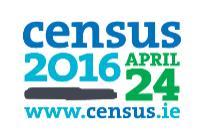
The 2016 census of Ireland was held in 2016. It was organised by the Central Statistics Office (CSO) and reported a total population of 4,761,865, or a 3.8% increase since the prior 2011 census. This was the lowest recorded population growth rate since the 1991 census, with the decline in population growth rates attributed to both lower birth rates and lower net migration. The census results were released gradually between April and December 2017 in a series of reports organised either as summaries or in-depth results of specific themes, like age, ethnicity, or religion.
















